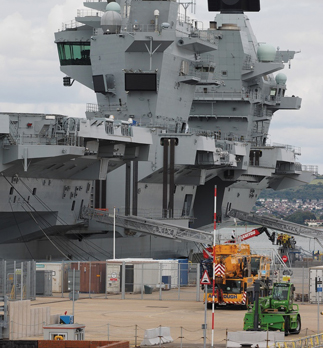Last year saw infrastructure works at Portsmouth Naval Base to modernise facilities and prepare for the arrival of the Royal Navy’s two new 65,000 tonne Queen Elizabeth Class aircraft carriers. The site houses defence assets and sees 120,000 visitors annually and 15,000 daily workers.
BAE Systems identified Jacksons Fencing to provide security and access products at a number of places on the naval base, including end-to-end specification and installation of onsite fencing, without the need for third parties.
Princess Royal Jetty needed to be secured from the rest of the naval base. Jacksons installed 440 metres of its Trident Securi-Mesh as well as one large sliding gate, five manual double leaf swing gates and six turnstiles. The fencing is overlapped by a minimum of 75mm at the posts. It has clamp bar fixings to provide extra resistance to penetration attempts, and anti-climb design to prevent potential intruders from bypassing the perimeter from above. It also has clamp bar fixings and anti-climb design. Jacksons completed the works in time for the new aircraft carrier to set sail from its new home dock in late October 2017.
At Trafalgar Gate, the main entrance and pass office to the naval base, fencing needed to be replaced. Jacksons installed 220m of the Trident Securi-Mesh fencing as well as turnstiles.
HMS Warrior 1860 at Portsmouth Historic Dockyard is open to the paying public and tourists. The publicly accessible site has a separate entrance at the Victory Gate and shares a beach border with the off-limits Naval Base. Hence fencing was required to ensure that the barrier between the general public areas and the Naval Base was not penetrable. Jacksons’s Trident Xtreme 3XM was installed on the beach and ran out into the sea. It was double galvanised and marine powder coated black to ensure it was protected from the elements. The Trident Xtreme 3XM system was chosen for its strong and rigid structure. It has vertical bars featuring a fully welded tubular stopped pale-through-rail construction with horizontal railed sleeved on to the upright posts with concealed fixings. Pale-through-rail design adds strength to the fencing and ensures that no bolts or palings can be removed or prised apart. The closely spaced pales, wall thickness and cut-delay technology, is designed to frustrate and deter attempts to penetrate the fence, the makers say. It provides visibility which aids surveillance tools and incorporates anti-climb design.
An out-of-service Harrier jet which served the Royal Navy for more than 30 years, is also housed within the Portsmouth Naval Base and is not accessible by the public. To protect this, Jacksons installed a pedestrian guardrail around helping to showcase the display without intruding on its appearance. The welded hollow tubular rail and solid pale construction is extremely strong and features a bolt-together design for ease of installation or replacement.
Cris Francis, Security Consultant at Jacksons Fencing, said: “Jacksons successfully balanced the need for both access and exclusion in perimeter security for all of these projects at Portsmouth Naval Base. Due to the age and nature of the site, there were many challenges in the design and installation which we had to overcome. The specification and installation was completed entirely by Jacksons, meaning a more efficient fully rounded service was successfully delivered.”










